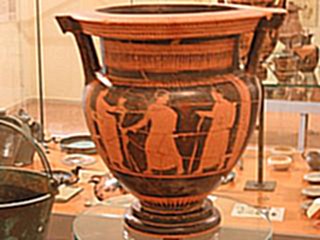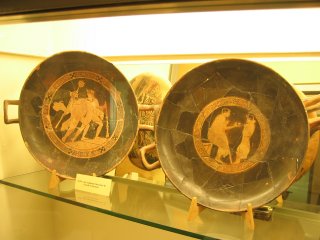The Etruscan town of Marzabotto was founded in the early 5th century B.C. in the valley where the river Reno flows, along the main part of the Appennini which links the so-called Tyrrenian Etruria with Bologna -the ancient Felsina- and Etruria Padana.
 During
the second half of 6th century B.C., the very complex urban structure
of this town, which is still visible today for most part of it, was the place of
a village constituted only by simple huts, but with some handicraft centres and
a small worship place. At the beginning of the 5th century B.C. the
proper town was founded and planned according to rational urban criteria. In
fact, from the main broad streets 15 metres wide that crossed the urban area
from North to South and from East to West, the area was divided in large sectors
called “regions”. These zones were further subdivides into suburbs, thanks to
other smaller streets 5 metres wide that went from North to South. Houses were
built within those suburbs.
During
the second half of 6th century B.C., the very complex urban structure
of this town, which is still visible today for most part of it, was the place of
a village constituted only by simple huts, but with some handicraft centres and
a small worship place. At the beginning of the 5th century B.C. the
proper town was founded and planned according to rational urban criteria. In
fact, from the main broad streets 15 metres wide that crossed the urban area
from North to South and from East to West, the area was divided in large sectors
called “regions”. These zones were further subdivides into suburbs, thanks to
other smaller streets 5 metres wide that went from North to South. Houses were
built within those suburbs. The
only remains we have from the houses are the cobble foundations and the ruins of
roofs, which were made of roofing-tiles and bent-tiles. From the planimetrical
point of view, all the houses present a clear uniformity: they are placed around
a central, open-air court in which sometimes it is possible to find a well.
Generally, the rooms that were used for commercial activities and handicraft
were along the main streets, as well as the huge workshops for clay and metal
work. In those buildings, great brick-kilns and shells are still visible.
The
only remains we have from the houses are the cobble foundations and the ruins of
roofs, which were made of roofing-tiles and bent-tiles. From the planimetrical
point of view, all the houses present a clear uniformity: they are placed around
a central, open-air court in which sometimes it is possible to find a well.
Generally, the rooms that were used for commercial activities and handicraft
were along the main streets, as well as the huge workshops for clay and metal
work. In those buildings, great brick-kilns and shells are still visible.At the extreme North and East edges of the town we find two graveyards (Sepolcreti). The tombs were made of travertine plates and modelled on cylinder shape. Outdoors, they were indicated by various funeral signs: great cobble stones, sometimes elaborated monuments like small columns, onion-shaped stones and memorials, which could be decorated too.

A view of the East graveyard
Another sacred area, the fountain-sanctuary, was set outside the centre, in the North-East, near a water spring which was believed to have a wealthy power. The sanctuary was well-structured and decorated, as the remains of the roof decoration and the furniture, displayed in the Museum, clearly demonstrate.
The town life saw an end around the middle of 4th century B.C. with the arrival of the Gauls in the Po valley. The Gauls occupied certain parts of the inhabited Etruscan area; they also built a graveyard at the foot of the Acropolis. From then onwards, the town has not been properly invaded anymore for centuries and that is why it remains the only and unique example of a totally preserved Etruscan town. The Museum The National Etruscan Museum “Pompeo Aria” is located within the archaeological site. In its exhibition rooms we find all the material which refers to the different stages of the town invasions: from the second half of 6th century B.C. to the Gallic invasion and the Roman period, when a farm was built in a peripheral area of the town. Objects are displayed according to topographical and chronological criteria and the Museum owns a rich didactic apparatus, such as the partial reconstructions of the roofs.

